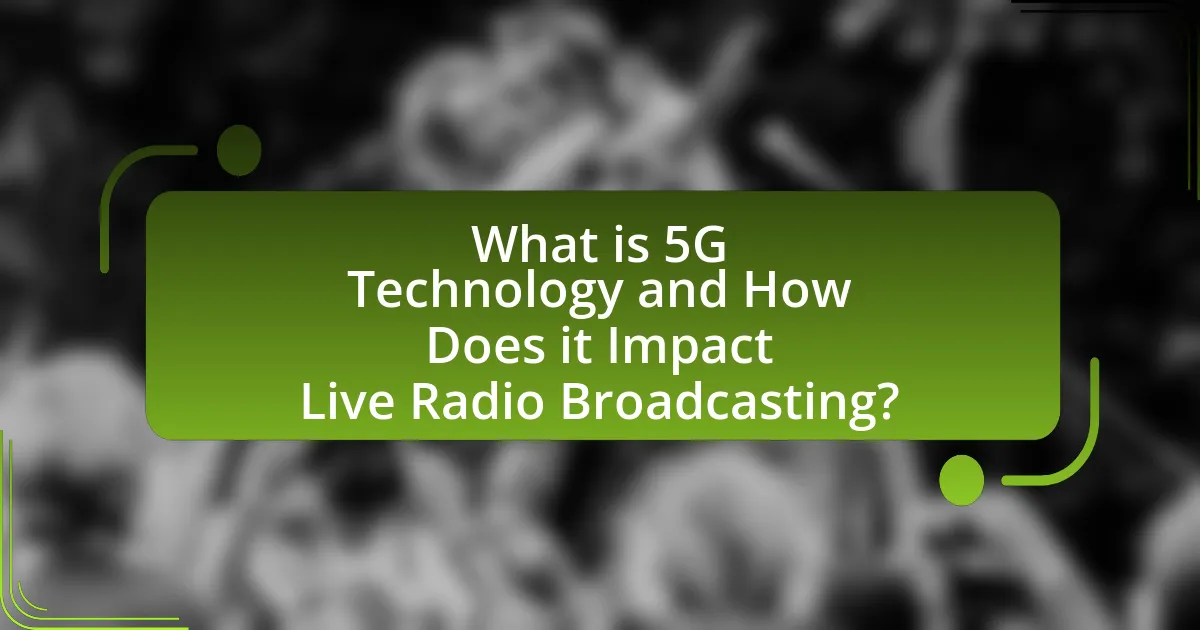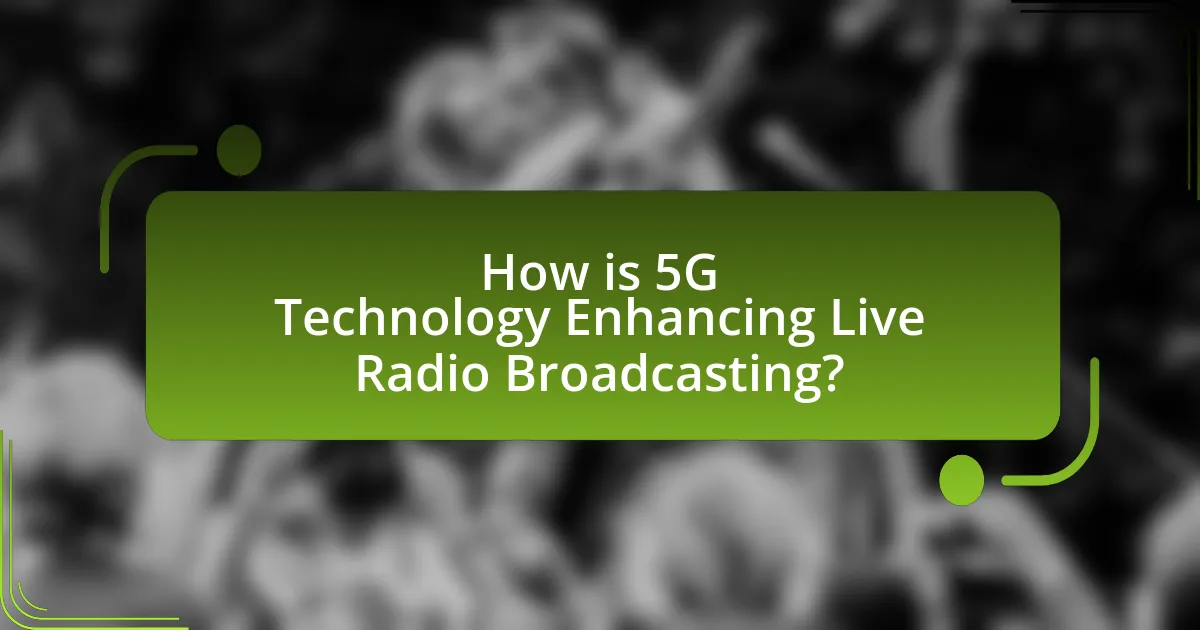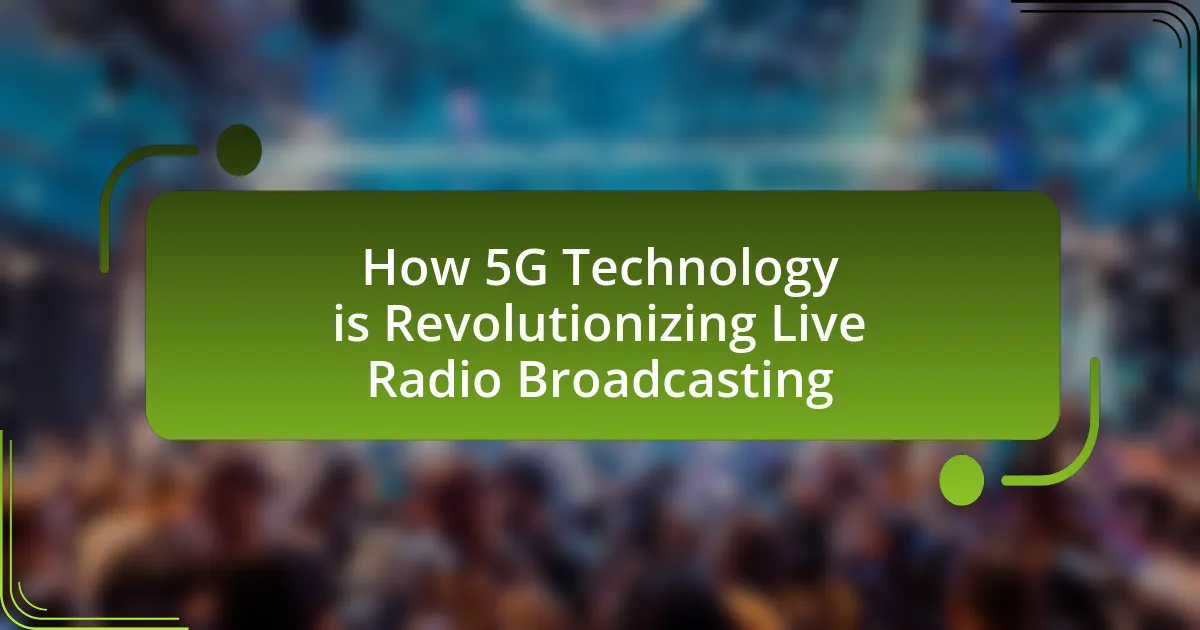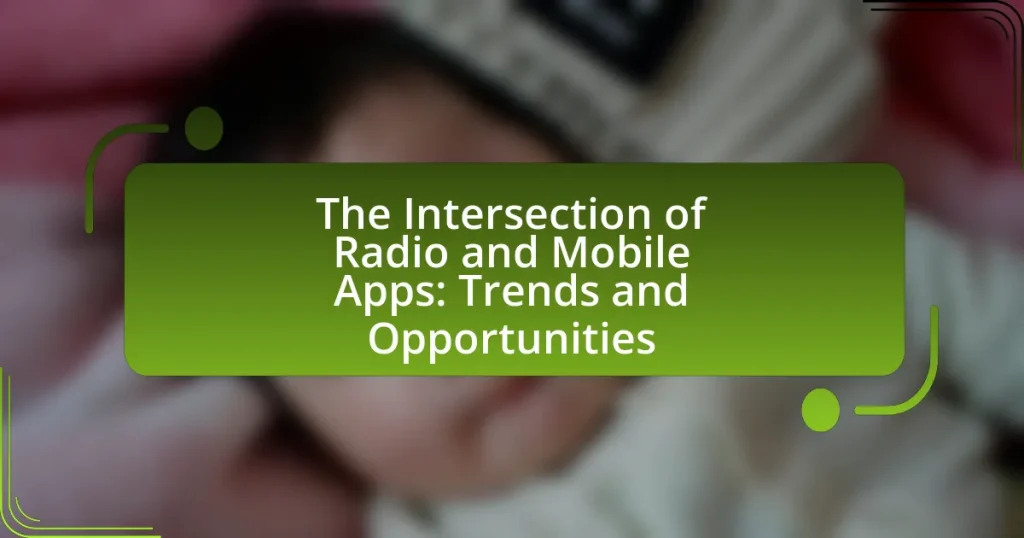5G technology represents the fifth generation of mobile networks, offering enhanced data speeds, reduced latency, and increased capacity, which significantly impacts live radio broadcasting. This advancement allows for real-time streaming of high-quality audio and video, improving listener engagement through features like interactive audience participation. The article explores how 5G differs from previous generations, its key features, and the challenges faced by traditional broadcasting without 5G. Additionally, it discusses the transformative benefits of 5G for audio quality, broadcast delays, and new broadcasting formats, while also addressing the infrastructure changes and best practices necessary for broadcasters to successfully adopt this technology.

What is 5G Technology and How Does it Impact Live Radio Broadcasting?
5G technology is the fifth generation of mobile network technology, offering significantly faster data speeds, lower latency, and greater capacity compared to its predecessors. This advancement impacts live radio broadcasting by enabling real-time streaming of high-quality audio and video content, enhancing listener experiences through improved reliability and reduced buffering. For instance, 5G can support multiple high-definition audio streams simultaneously, allowing broadcasters to deliver diverse content without interruption. Additionally, the low latency of 5G facilitates interactive features, such as live audience participation and instant feedback, which can transform traditional broadcasting into a more engaging and dynamic experience.
How does 5G technology differ from previous generations?
5G technology differs from previous generations primarily through its significantly higher data transfer speeds, lower latency, and increased capacity for connected devices. Specifically, 5G can achieve speeds up to 10 Gbps, compared to 4G’s maximum of around 1 Gbps, enabling faster downloads and improved streaming quality. Additionally, 5G reduces latency to as low as 1 millisecond, enhancing real-time communication and responsiveness, which is crucial for applications like live radio broadcasting. Furthermore, 5G networks can support up to 1 million devices per square kilometer, vastly improving connectivity in densely populated areas compared to 4G’s limitations. These advancements make 5G a transformative technology for various sectors, including media and entertainment.
What are the key features of 5G technology?
The key features of 5G technology include enhanced data speeds, reduced latency, increased capacity, and improved connectivity. Enhanced data speeds can reach up to 10 Gbps, significantly faster than 4G, enabling high-definition streaming and real-time applications. Reduced latency, often as low as 1 millisecond, allows for instantaneous communication, which is crucial for applications like remote surgery and autonomous vehicles. Increased capacity supports a higher number of devices per square kilometer, accommodating the growing Internet of Things (IoT). Improved connectivity ensures reliable service in densely populated areas, making it ideal for urban environments. These features collectively enable transformative applications across various sectors, including live radio broadcasting, where real-time interaction and high-quality audio streaming are essential.
How does latency in 5G compare to 4G and earlier technologies?
Latency in 5G is significantly lower than in 4G and earlier technologies, with 5G achieving latency as low as 1 millisecond compared to 4G’s latency of around 30 to 50 milliseconds. This drastic reduction in latency enhances real-time communication and responsiveness, which is crucial for applications like live radio broadcasting. The improved latency in 5G is made possible by advancements in network architecture and technology, such as edge computing and network slicing, which optimize data transmission and processing.
What challenges does live radio broadcasting face without 5G?
Live radio broadcasting faces significant challenges without 5G, primarily due to limitations in bandwidth, latency, and connectivity. Traditional broadcasting technologies struggle to deliver high-quality audio and real-time interaction, especially in remote or crowded areas where network congestion occurs. For instance, 4G networks may not provide sufficient data speeds for high-definition audio streaming, leading to interruptions and degraded sound quality. Additionally, the higher latency associated with non-5G networks can hinder live interactions, making it difficult for broadcasters to engage with audiences in real-time. These challenges can ultimately affect listener experience and the overall effectiveness of live broadcasts.
How do bandwidth limitations affect live radio broadcasts?
Bandwidth limitations significantly impact live radio broadcasts by restricting the amount of data that can be transmitted, which affects audio quality and reliability. When bandwidth is limited, broadcasters may experience lower bit rates, leading to compressed audio that can degrade sound clarity and listener experience. For instance, traditional FM radio operates within a bandwidth of 200 kHz, while digital broadcasts require more bandwidth to deliver higher quality audio. In scenarios where bandwidth is insufficient, interruptions or delays can occur, compromising the live nature of broadcasts. This is particularly critical in emergency broadcasting situations where timely and clear communication is essential.
What are the common issues with signal reliability in traditional broadcasting?
Common issues with signal reliability in traditional broadcasting include interference, signal degradation, and limited coverage areas. Interference from physical obstacles, such as buildings and terrain, can disrupt the transmission of signals, leading to poor audio quality or loss of signal altogether. Signal degradation occurs due to distance from the transmitter, where the strength of the signal diminishes, affecting clarity and consistency. Additionally, traditional broadcasting often faces challenges in reaching remote or rural areas, resulting in inconsistent service availability. These factors collectively hinder the reliability of traditional broadcasting signals.

How is 5G Technology Enhancing Live Radio Broadcasting?
5G technology enhances live radio broadcasting by providing significantly higher data transfer speeds and lower latency compared to previous generations. This allows radio stations to transmit high-quality audio and video content in real-time, improving listener experience and engagement. For instance, 5G can support multiple high-definition audio streams simultaneously, enabling broadcasters to offer diverse programming without interruption. Additionally, the increased bandwidth facilitates remote broadcasting capabilities, allowing journalists to report live from various locations with minimal delay. According to a report by the International Telecommunication Union, 5G networks can achieve speeds up to 10 Gbps, which is crucial for delivering seamless live broadcasts.
What are the primary benefits of using 5G for live radio broadcasting?
The primary benefits of using 5G for live radio broadcasting include enhanced data transmission speeds, reduced latency, and increased network capacity. Enhanced data transmission speeds allow for higher quality audio and video streaming, enabling broadcasters to deliver clearer and more immersive content. Reduced latency, which can be as low as one millisecond, ensures real-time interaction during live broadcasts, improving audience engagement. Increased network capacity supports more simultaneous connections, allowing multiple broadcasters to operate without interference, which is crucial during events with high listener demand. These advantages collectively transform the efficiency and quality of live radio broadcasting.
How does 5G improve audio quality in live broadcasts?
5G improves audio quality in live broadcasts by providing higher bandwidth and lower latency, which enables real-time transmission of high-fidelity audio. The increased bandwidth allows for the transfer of more data simultaneously, resulting in clearer sound and reduced compression artifacts. Additionally, the lower latency minimizes delays in audio delivery, ensuring synchronization between audio and video feeds. These enhancements lead to a more immersive listening experience, as evidenced by trials conducted by various broadcasters that demonstrate significant improvements in audio clarity and responsiveness when utilizing 5G networks.
What role does 5G play in reducing broadcast delays?
5G significantly reduces broadcast delays by providing ultra-low latency communication, typically around 1 millisecond, compared to 4G’s latency of 30-50 milliseconds. This drastic improvement allows for real-time transmission of audio and video content, enabling live broadcasts to occur with minimal lag. The high bandwidth of 5G networks supports the simultaneous transmission of multiple high-definition streams, further enhancing the efficiency of live broadcasting. As a result, 5G technology facilitates immediate interaction between broadcasters and audiences, transforming the experience of live radio broadcasting.
How does 5G technology enable new broadcasting formats?
5G technology enables new broadcasting formats by providing significantly higher data transfer speeds, lower latency, and increased network capacity. These advancements allow for the transmission of high-definition video and audio content in real-time, facilitating immersive experiences such as augmented reality and virtual reality broadcasts. For instance, 5G can support multiple simultaneous streams without degradation in quality, which is essential for live events and interactive broadcasting. The technology’s ability to connect a vast number of devices simultaneously also enhances audience engagement through real-time interactions and personalized content delivery.
What opportunities does 5G create for immersive audio experiences?
5G technology creates significant opportunities for immersive audio experiences by enabling high-speed data transmission and low latency, which are essential for real-time audio streaming. This enhanced connectivity allows for multi-channel audio delivery, enabling listeners to experience sound from various directions, thus creating a more engaging and realistic auditory environment. For instance, 5G’s capacity to support high-definition audio formats and spatial audio technologies can transform live radio broadcasting by allowing listeners to feel as if they are part of the event, rather than just passive recipients. Additionally, the increased bandwidth of 5G facilitates seamless integration of augmented reality (AR) and virtual reality (VR) audio experiences, further enriching the listener’s engagement with content.
How can 5G facilitate remote broadcasting capabilities?
5G can facilitate remote broadcasting capabilities by providing high-speed, low-latency connections that enable seamless transmission of high-definition audio and video content. This technology supports real-time data transfer, allowing broadcasters to stream live events from remote locations without the need for extensive physical infrastructure. For instance, 5G networks can achieve download speeds exceeding 1 Gbps and latency as low as 1 millisecond, which significantly enhances the quality and reliability of live broadcasts. This capability is particularly beneficial for events such as sports, concerts, and news coverage, where immediate and high-quality transmission is crucial.

What are the Future Implications of 5G in Live Radio Broadcasting?
The future implications of 5G in live radio broadcasting include enhanced audio quality, reduced latency, and increased connectivity for remote broadcasting. 5G technology enables higher data transfer rates, allowing broadcasters to deliver high-definition audio streams with minimal delay, which is crucial for live events. Additionally, the low latency of 5G facilitates real-time interactions between hosts and listeners, improving audience engagement. Furthermore, 5G’s ability to connect multiple devices simultaneously supports the use of advanced broadcasting tools, such as augmented reality and interactive content, thereby transforming the listener experience. These advancements are supported by industry reports indicating that 5G can achieve speeds up to 10 Gbps, significantly surpassing 4G capabilities, which enhances the overall efficiency and quality of live radio broadcasting.
How might 5G technology shape the future of radio content delivery?
5G technology will significantly enhance radio content delivery by providing faster data transmission speeds, lower latency, and increased capacity for simultaneous connections. This advancement allows radio broadcasters to deliver high-quality audio and video content in real-time, improving listener experiences and enabling interactive features such as live polling and audience engagement. According to a report by the GSMA, 5G networks can achieve speeds up to 10 Gbps, which is substantially higher than 4G, facilitating seamless streaming and reducing buffering times. Additionally, the low latency of 5G, often under 1 millisecond, supports real-time interactions, making live broadcasts more dynamic and engaging for audiences.
What innovations can we expect in radio broadcasting with 5G?
5G technology is expected to bring significant innovations to radio broadcasting, including enhanced audio quality, lower latency, and improved interactivity. The increased bandwidth of 5G allows for high-definition audio streaming, which can elevate the listening experience for audiences. Additionally, the reduced latency enables real-time interactions during live broadcasts, allowing listeners to engage with hosts and participate in discussions seamlessly. Furthermore, 5G’s capacity for massive device connectivity can facilitate the integration of IoT devices in broadcasting, enabling personalized content delivery and targeted advertising. These advancements are supported by industry reports indicating that 5G can support up to 1 million devices per square kilometer, enhancing the overall capabilities of radio broadcasting.
How will audience engagement change with 5G-enabled broadcasts?
Audience engagement will significantly increase with 5G-enabled broadcasts due to enhanced connectivity and lower latency. The introduction of 5G technology allows for real-time interaction, enabling listeners to participate in live polls, request songs, and engage with hosts instantly. According to a report by the GSMA, 5G networks can support up to one million devices per square kilometer, facilitating a more interactive experience for users. This capability transforms traditional broadcasting into a two-way communication channel, fostering a deeper connection between broadcasters and their audience.
What are the potential challenges and considerations for broadcasters adopting 5G?
Broadcasters face several potential challenges and considerations when adopting 5G technology, including infrastructure costs, spectrum availability, and compatibility with existing systems. The transition to 5G requires significant investment in new infrastructure, which can strain budgets, especially for smaller broadcasters. Additionally, the availability of suitable spectrum for 5G services can vary by region, potentially limiting access and deployment options. Compatibility with legacy broadcasting systems poses another challenge, as broadcasters must ensure that new 5G technologies can integrate seamlessly with their current operations. These factors highlight the complexities involved in adopting 5G for live radio broadcasting.
What infrastructure changes are necessary for 5G implementation in radio?
The infrastructure changes necessary for 5G implementation in radio include the deployment of small cell networks, enhanced backhaul capabilities, and the integration of advanced antenna technologies. Small cell networks are crucial as they provide the dense coverage required for high-frequency 5G signals, which have a shorter range compared to previous generations. Enhanced backhaul capabilities are needed to support the increased data traffic and lower latency that 5G offers, ensuring that data can be transmitted efficiently from the radio stations to the network. Additionally, advanced antenna technologies, such as Massive MIMO (Multiple Input Multiple Output), are essential for improving signal quality and capacity, allowing multiple users to connect simultaneously without degradation of service. These changes are supported by industry reports indicating that 5G can deliver data rates up to 10 Gbps and significantly reduce latency to as low as 1 millisecond, which are critical for live broadcasting applications.
How can broadcasters ensure a smooth transition to 5G technology?
Broadcasters can ensure a smooth transition to 5G technology by investing in infrastructure upgrades, training staff, and collaborating with technology partners. Upgrading infrastructure is essential as 5G requires new equipment and network capabilities to handle increased data speeds and lower latency. Training staff on 5G technology and its applications in broadcasting will enhance operational efficiency and content delivery. Collaborating with technology partners allows broadcasters to leverage expertise and resources, facilitating a more effective integration of 5G into their existing systems. According to a report by the International Telecommunication Union, the successful implementation of 5G in broadcasting can lead to improved audience engagement and new revenue streams, underscoring the importance of these strategies.
What best practices should broadcasters follow when utilizing 5G technology?
Broadcasters should prioritize network reliability and coverage when utilizing 5G technology to ensure seamless transmission. This involves selecting locations with strong 5G signals and conducting thorough testing before live broadcasts. Additionally, broadcasters should invest in compatible equipment that maximizes the benefits of 5G, such as low-latency encoders and high-quality microphones. Implementing robust cybersecurity measures is also essential to protect sensitive data transmitted over 5G networks. Furthermore, broadcasters should stay informed about evolving 5G standards and regulations to remain compliant and leverage new features effectively. These practices enhance broadcast quality and operational efficiency, aligning with the transformative potential of 5G in live radio broadcasting.



